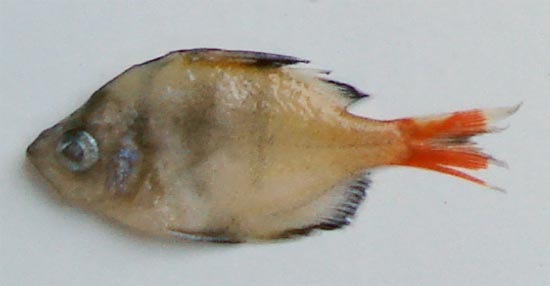
Synonyms:
Ambassis ranga: Day, 1878; Day, 1889; Shaw and Shebbeare, 1937; Ahmad, N. 194; Bhuiyan, 1964.
Chanda ranga: Hamilton, 1822; Menon, 1974.
Chanda lala: Hamilton, 1822.
Common name: Indian glassy fish (English name).
Bangla name: Lal chanda, Ranga chanda.
Taxonomic position:
Phylum: Chordata
Class: Osteichthyes
Order: Perciformes
Family: Centropomidae
Genus: Chanda
Species: C. ranga
Morphological description:
Body length is comparatively short from other Chanda species and body is deeply compressed. Head is also short and compressed and the snout is sharp. Lateral line is partly distinct and partly absent. Lower jaw is longer than the upper jaw. Caudal forked. In shape and colour this fish resembles chanda nama but it is rather deeper in the body and shorter in length than the chanda nama. The chief distinction is in teeth which are all small in Chanda ranga. The general body colour transparent yellowihs white. Outer edge of both dorsals, anal and caudal tinged black. In young specimens which are locally known as “Lal chanda” the body is brightly coloured with red and yellow. Dorsals, anal and caudal scarlet is red. First dorsal and pelvic black tipped. The morphological description of this species is quite similar to Rahman (2005), Bhuiyan (1964), Yadav (1997) and Talwar and Jhingran (2001).
Fin formula:
D1. VI-VII, D2. I/12-15, P1. I/9-12, P2. I/5, A. III/14-15.
D1. 7-8, D2. 1/13-15, P1. 11, P2. 6, A. 3/14-16 (Bhuiyan, 1964).
D1. VII/8, D2. I/13-15, P1. 11, P2. 6, A. III/14-16 (Shafi and Quddus, 1982).
D1. VI, D2. I/13-15, P1. 10-11, P2. I/5, A. III/15-16 (Rahman, 2005).
D. VII+I 11-14, P1. i 11-12, P2. I 5, A. III 13-15 (Talwar and Jhingran, 2001).
Habit and habitat:
This fish is found in the clear streams, beels and canals. Most abundant found during rainy season. It feeds on larvae and pupae of mosquito (Bhuiyan, 1964). Iqbal, et. al. (1995-96) also described about feeding habit of Chanda ranga.
Breeding time:
Breeding time of this species is May-October. It breeds in confined water (Talwar and Jhingran, 2001).
Economic importance:
This species is popular small indigenous species of fish of Bangladesh. Most of them are taken for drying in Northern region of Bangladesh. It is very much famous food in rural Bangladesh. Good source of nutrition but low price in the market. Though it is small and bony people like it as food (Rahman, 2005).
Ecological role:
Ahmad (1943) states that the fish breeds freely in confined water. In confinement, on an average it feeds on about 120 larvae and pupae of mosquito a day during the first few days but this number continues to decrease as time passes.
Marketing status:
Market value of fresh fish varied between 25-35 Tk/kg.
References:
Ahmad, N. 1943. “Fauna of Lahore. 5 Fishes of Lahore.” Bull. Dep. Zoo1 Punjub Univ. Lahore. pp. 253-374.
Bhuiyan, A.L. 1964. Fishes of Dacca. Asiatic Soc. Pakistan, Publ. No. 13, Dacca. pp. 101-102.
Day, F. 1878. Fishes of India. William Dowson and sons., London. p. 51.
Day, F. 1889. Fishes. Fauna. Brit. India. William Dowson and sons., London. 1-2: p. 484.
Hamilton, F. 1822. Fishes of the Ganges. Archibald constable and company, Edinburgh. pp. 113-114.
Iqbal, S.M., Mortuza, M.G., Parween, S. and Hossain, M.A. 1995-1996. Length-weight relationship and condition factor of chanda nama (Hamilton) and chanda ranga (Hamilton). Rajshahi University studies (Part-B). 23-24: p. 238-242.
Menon, A.G.K. 1974. Fishes of the Himalayan and Indo-Gangetic Plains. Inland Fisheries Society of India SP. Publ. 1. p.136.
Rahman, A.K.A. 2005. Freshwater Fishes of Bangladesh. The Zoological Society of Bangladesh, Dhaka. pp. 340-341.
Shafi, M. and Quddus, M.M.A. 1982. Bangladesher Matshya Sampad (in Bengali). Dhaka. pp. 268-269.
Shaw, G.E. and Shebbeare, E.O. 1937. Fishes of Northern Bengal. J. Royal Asiat. Soc. Bengal Science. p. 110.
Talwar, P.K. and Jhingran, A.G. 2001. Inland Fishes of India and Adjacent countries. Oxford and IBH Publishing Co. Pvt. Ltd. New Delhi. 2: pp. 805-806.
Yadav, B.N. 1997. Fish and Fisheries. Daya Publishing House, Calcutta. p. 320.
Visited 5,852 times, 1 visits today | Have any fisheries relevant question?
